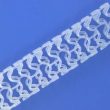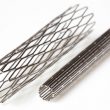The US Food and Drug Administration (FDA) has issued an alert on the potential long-term risk of paclitaxel-coated balloons and paclitaxel-eluting stents in patients with femoropopliteal artery disease. This agency is evaluating signals of increased long-term deaths among patients with femoral or popliteal artery disease treated with paclitaxel-coated devices in a recent study. In<a href="https://solaci.org/en/2019/03/15/fda-alert-on-drug-coated-balloons-and-stents-in-femoropopliteal-artery-disease/" title="Read more" >...</a>
Drug eluting Stents vs. Drug Coated Balloons for In-Stent Restenosis
The rationale behind the decision to not add another layer of metal to the artery sounded attractive and this was what paved the way for drug coated balloons as an alternative strategy to treat in-stent restenosis. “We’ve already got a stent in place, we only have to dilate and leave the drug” is what we<a href="https://solaci.org/en/2019/03/14/drug-eluting-stents-vs-drug-coated-balloons-for-in-stent-restenosis/" title="Read more" >...</a>
SYNTAX II: Better Stents, IVUS, FFR, or a Combination of All of Them to Catch Up with Surgery
In patients with 3-vessel disease, surgery obtained better outcomes than angioplasty, according to results from the SYNTAX and FREEDOM trials, which used first-generation drug-eluting stents. Even in the BEST trial, which used new-generation stents, surgery still offered far better outcomes. Nobody is surprised by the fact that, whenever angioplasty evolves due to a new device<a href="https://solaci.org/en/2017/09/13/syntax-ii-better-stents-ivus-ffr-or-a-combination-of-all-of-them-to-catch-up-with-surgery/" title="Read more" >...</a>
Are Bioresorbable-Polymer Stents More Thrombogenic than Durable-Polymer Second-Generation Stents?
Courtesy of Dr. Cristian Jesús Rodríguez. Most stents currently used in percutaneous coronary intervention (PCI) are durable-polymer second-generation drug-eluting stents (DP-DES, with everolimus or zotarolimus). However, it has been argued that the persistence of such a polymer after complete drug elution is one of the main factors for a dangerous complication: stent thrombosis (ST). After<a href="https://solaci.org/en/2017/08/23/are-bioresorbable-polymer-stents-more-thrombogenic-than-durable-polymer-second-generation-stents/" title="Read more" >...</a>
Biodegradable-polymer stents are as safe as permanent-polymer stents in a 5-year follow-up
Courtesy of Dr. Carlos Fava. One of the questions around drug-eluting stents (DES) is whether the development of biodegradable polymers would derive in better outcomes than the performance of durable polymers as regards the presence of events. In consequence, the COMPARE II trial was carried out with the aim of testing them in “real-world” patients. This<a href="https://solaci.org/en/2017/06/13/biodegradable-polymer-stents-are-as-safe-as-permanent-polymer-stents-in-a-5-year-follow-up/" title="Read more" >...</a>
Promising Outcomes of Overlapping Stents in Patients Undergoing Bioresorbable Scaffold (BRS) Implantation
Courtesy of Dr. Guillermo Migliaro. In regular clinical practice, overlapping stents are reported in up to 30% of patients undergoing coronary angioplasty, especially due to very long lesions requiring implantation of multiple stents or dissection after the implantation of a first stent. In bare metal stent era, overlapping was associated with unfavorable clinical outcomes<a href="https://solaci.org/en/2017/05/08/promising-outcomes-of-overlapping-stents-in-patients-undergoing-bioresorbable-scaffold-brs-implantation/" title="Read more" >...</a>
Bifurcation Lesion in Distal Left Main Coronary Artery: One or Two Stents?
Courtesy of Dr. Carlos Fava. Unprotected left main coronary artery (LMCA) angioplasty has become an important trend in the last few years. One of the most significant unresolved questions about it is whether one stent is better than two in distal lesions, and how is their progress after treatment. This study included 937 patients who<a href="https://solaci.org/en/2016/11/16/bifurcation-lesion-in-distal-left-main-coronary-artery-one-or-two-stents/" title="Read more" >...</a>
Chronic Total Occlusion: Bioresorbable Scaffolds or Drug Eluting Stents?
There is little evidence to support the safety and efficacy of bioresorbable scaffolds (BRS) for the treatment of chronic total occlusions (CTO). This multicenter registry included consecutive patients with CTO receiving BRS (Absorb; Abbott Vascular) vs. 2nd generation drug eluting stents (DES). Primary end point was target vessel failure at long term (composite<a href="https://solaci.org/en/2016/10/24/chronic-total-occlusion-bioresorbable-scaffolds-or-drug-eluting-stents/" title="Read more" >...</a>
Current Bare-Metal Stents: Similar to DES in the Very Long-Term
The largest randomized trial in history found no difference in the primary endpoint of death and nonfatal infarction between current conventional stents and drug-eluting stents at over 5 years in patients with stable or unstable coronary disease. As expected, NORSTENT did find a difference in revascularization rates between both groups. This study presented at the<a href="https://solaci.org/en/2016/09/07/current-bare-metal-stents-similar-to-des-in-the-very-long-term/" title="Read more" >...</a>
Instent restenosis: Drug eluting balloons or drug eluting stents?
Original Title: Long-Term Results of Everolimus-Eluting Stents versus Drug-Eluting Balloons in Patients with Bare-Metal In-Stent Restenosis 3-Year Follow-Up of the RIBS V Clinical Trial. Reference: Alfonso F. et al. JACC Cardiovasc Interv. 2016 Jun 27;9(12):1246-55. Courtesy of Dr. Agustín Vecchia. RIBS V 3 year follow up Stents have become the gold standard for<a href="https://solaci.org/en/2016/06/28/instent-restenosis-drug-eluting-balloons-or-drug-eluting-stents/" title="Read more" >...</a>









